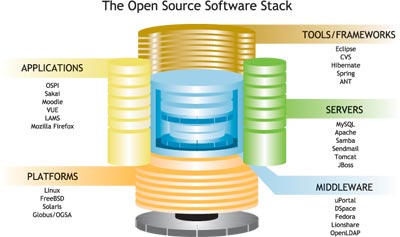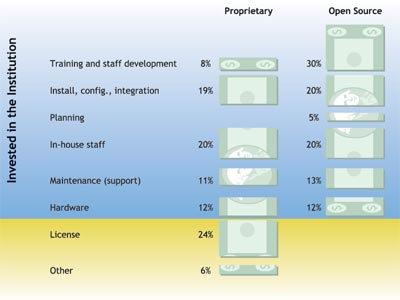Will Open Source Software Unlock the Potential of eLearning?
Technology has great potential to expand and improve the ways people learn,
yet eLearning has done little more than mimic earlier learning and teaching
practices. Why isn't technology living up to its tremendous potential? The answer
may be, in part, that education has been treated as a market of learning
rather than an environment for learning. Markets, and the commercial
considerations at their base, are driven toward uniformity and reproducibility.
Environments, structured with educational underpinnings, support diversity,
a requirement for the experimentation needed to unlock the potential of eLearning.
Open source applications
You've probably noticed the "buzz" about open source this past year.
Open source is a way of building, owning, and using software as a community.
Online, in the journals, in meetings, and in hallway conversations at conferences,
open source projects like Sakai, OSPI, uPortal, and others are getting a lot
of attention. In fact, Educause 2004 will probably be remembered as the tipping
point when the open source movement spread beyond the early adopters and innovators
who nurtured it over the past several years.
Open source is not a new phenomenon. It has a history nearly as rich and long
as the software industry itself. So why all of the buzz now? The buzz, I think,
is about the accelerated evolution of open source. For many years open source
has thrived, even dominated in many parts of the software stack. Probably the
most well known examples are the Linux operating system, the Apache Web server
that claims 67 percent market share, and uPortal, the most successful enterprise
portal among colleges and universities. The illustration below shows
prominent open source software in platforms, servers, middleware, and tools.
What is new and exciting is that in the past few years open source has spread
into a new part of the software stack--the applications layer. This evolution
brings open source in touch with many more users and offers an attractive alternative
to proprietary software, high prices, and limited innovation.

Open source provides users the freedoms to use, modify, and share software,
where proprietary software limits users' ability to do these things. Although
the freedoms of open source revolve around access and re-use of software and
source code, we'd miss the more important implications if we focused solely
on the code. Interchangeable parts and assembly line production sparked far
reaching soci'economic impacts we call the industrial revolution. The Internet,
which is largely built on top of open source software, has generated similar
impacts on societies worldwide. The processes of building open source software
and the economics of open source similarly have far-reaching implications.
The collaborative nature of open source has a strong cultural affinity to higher
education and its mission to advance and share knowledge for the greater public
good. This cultural fit stimulates adoption and leads to new collaborative practices
for building enterprise software, unlike any other industry sector. Leading
institutions are responding to the new opportunities presented by the evolution
of open source. There is a growing desire and ability to work together on projects
like Sakai, OSPI, uPortal, Fedora, and VUE. These communities develop and distribute
innovative enterprise software that competes with, and even drives innovation
in proprietary alternatives.
The open source movement can be viewed with many different lenses. For this
discussion, I'm going to focus on two things: (1) how open source can lead to
more effective use of technology, and (2) how open source can stimulate greater
innovation.
Using technology more effectively for learning and teaching
Aside from leveraging new media, proprietary eLearning software has done little
to improve learning and teaching. Two characteristics of proprietary software
make it ill-suited to the task: (1) the rapidly escalating cost of proprietary
software leaves too little of an institution's IT budget available for creative
exploration, once the software has been installed and minimally supported; (2)
reduced flexibility to adapt to institutional culture, teaching practices, and
disciplinary uniqueness occurs when software development is driven by mass market
economics.

Institutions that have the capacity to build their own software gain control
over their destiny and applications well suited to their needs, but bear the
full cost of development and maintenance over time. For some institutions this
may be an appealing option, but it still leaves precious little of the IT budget
for the non-software activities like planning, customization, and professional
development essential for success.
Open source software offers the potential to reduce the cost of the software
while providing an institution greater control over its destiny. Three characteristics
in particular make it an attractive solution:
- Elimination or reduction of license and maintenance fees leaves more budget
available to invest in adapting the software, managing organizational change,
providing professional development, and responding to end-user requests.
- Commercial services are kept in check by market forces, because companies
offering commercial support for open source software must compete on the quality
and value of their offering rather than relying on an artificial lock on customers
that makes switching prohibitive.
- Customizing open source software can be done more effectively because there
are few barriers to adapting, sharing, and collaboratively developing new
applications.
Stimulating eLearning innovation
Open source eLearning applications like Sakai, Moodle, and LAMS are reinvigorating
learning technology by making new eLearning systems available to the world.
These new open source systems have a number of advantages that make them excellent
platforms for innovation:
- Many schools adopting open source applications add functionality that solves
a local priority and then contribute these enhancements back to the community
so that others can benefit from their work. Proprietary systems depend on
the company that owns the system determining that there's a bottom-line justification
to add a new feature or enhance the software in some way. Resources have to
be allocated only to those features that satisfy the broadest possible market.
- Open source projects can provide a platform for experimentation so that
innovative projects exploring the edge of technology's reach can live on in
an enterprise environment already adopted by large numbers of institutions.
- Open source initiatives can be combined in novel ways to produce something
greater than the sum of the parts. Combinations like this are a key ingredient
for innovation and are prohibited with proprietary software.
In addition to the direct benefits of open source software, open source projects
also put intense market pressure on the proprietary alternatives to innovate
and add value. As open source alternatives to proprietary applications succeed,
they will drive down the cost of the proprietary alternative effectively turning
the application into a commodity. For example, if the core course management
system is a commodity, commercial enterprises must seek new ways to add value
to generate revenue from that commodity. One way to do so is to sell innovative
new capabilities protected as proprietary software. Eventually the open source
movement will replicate the commercial innovation and the company will need
to find new capabilities to continue adding value. This healthy cycle perpetuates
innovation.
Information and communications technologies (ICT) hold great promise for learning
and teaching because they can enhance interaction among people, information,
and systems in ways that never before have been possible. The proprietary eLearning
systems available today have only just begun to scratch the surface by delivering
content and connecting people across distance and time. Yet while these proprietary
systems have begun to show the promise of technology in teaching and learning,
they also seem to have hit an early plateau. Open source applications are standing
on that plateau looking forward.
Resources for more information:
Open source, opens learning
www.opensourcesummit.org
www.sakaiproject.org
www.theospi.org
www.ja-sig.org
www.moodle.org
www.lamsinternational.com
vue.tccs.tufts.edu